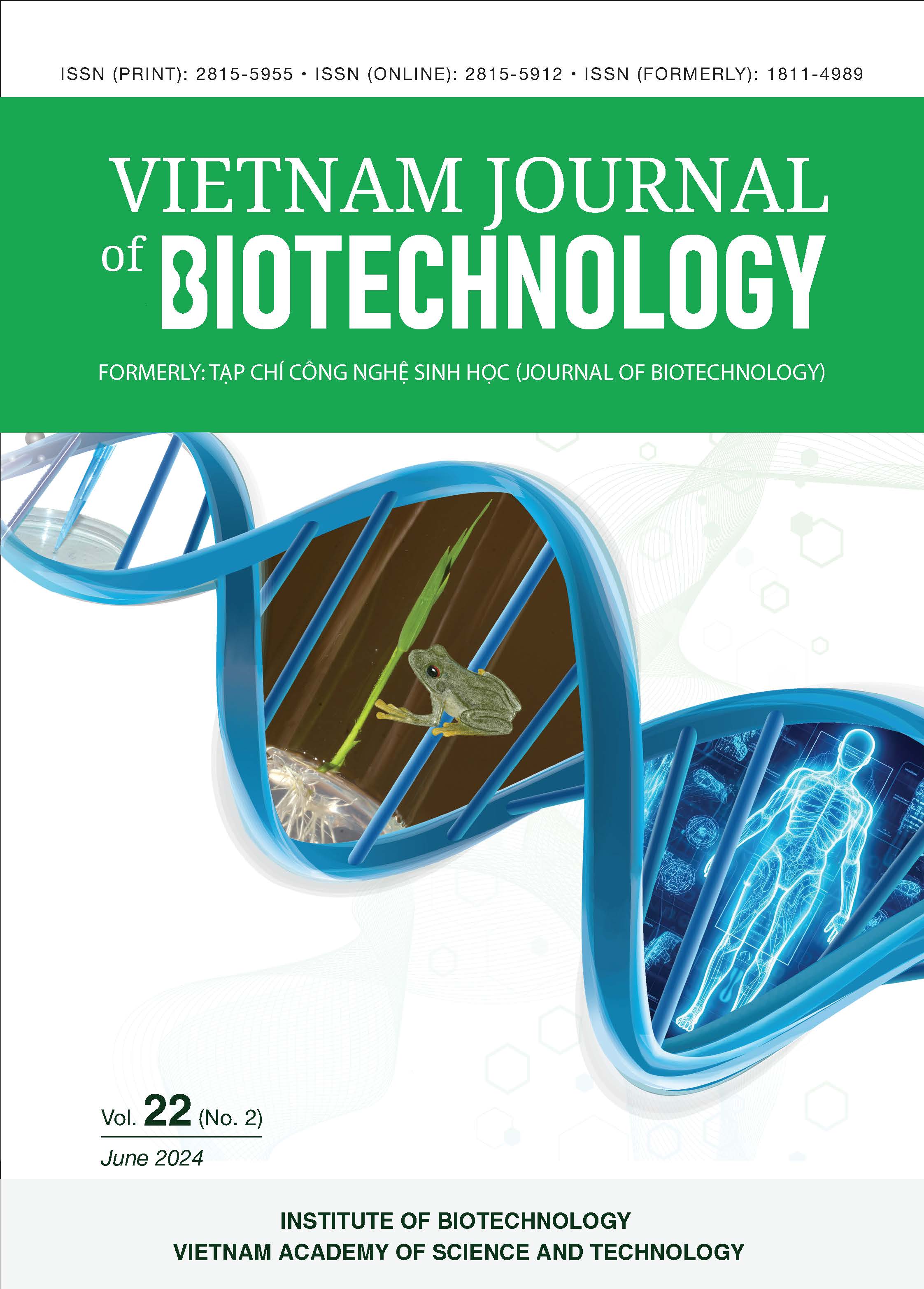Isolation and identification of the Serratia marcescens causing septicemia in the silkworms from Yen Bai province and prevention measures
Author affiliations
DOI:
https://doi.org/10.15625/vjbt-19680Keywords:
mulberry silkworm blood infection, prevention measures, Serratia marcescens, silkworm diseaseAbstract
In Yen Bai (Northern Viet Nam), sericulture is an important part of agriculture. However, bacterial diseases often cause severe economic loss in sericulture. The results of this research are the first to use a combination of biochemical identification methods and sequencing of the 16S rRNA gene region to diagnose and determine the origin of the pathogen causing septicemia in silkworms collected from Yen Bai province. From the collected silkworm samples with septicemia, a strain of Serratia marcescens bacteria was isolated with morphological characteristics, and typical basic biochemical test. Additionally, the 16S rRNA gene region of the bacterial strain S. marcescens was sequenced. Research results showed that the MD2-16-27F bacterial strain has 99.63% similarity with the S. marcescens strain JW-CZ2. Research on preventing this bacterium shows that the disinfection solution, which contains the active ingredients of trichloroisocyanuric acid (0.0008 mol), formaldehyde (0.0059 mol), calcium hypochloride (0.0031 mol) and alcohol (0.137 mol), effectively prevented the growth of this bacterium after exposed to it for 30 minutes at a temperature of 24-25oC. Antibiotic active ingredients, Norfloxacin (10 μg/l) and Doxycycline (30 μg/l), were effective in preventing S. marcescens bacterium with high sensitivity level; the antibacterial ring diameter of Doxycycline was 31 mm and that of Norfloxacin was 25 mm. The results of this study can be applied to the general prevention of septicemia in silkworms caused by S. marcescens bacteria in the Northern part of Vietnam, particularly in Yen Bai in particular and the North of our country in general.
Downloads
References
Aili Tao et al. (2022). Characterization of a novel chitinolytic Serratia marcescens strain TC-1 with broad insecticidal spectrum. AMB Express, Jul 30;12(1): 2-11 https://doi.org/10.1186/s13568-022-01442-6
Bergey. D.H, Breed. R.S. (2014) Bergey’s Manual of Determinative Bacteriology- 9th Edition-William & Wilkins.
Bernadett Baráti-Deák et al. (2023). Inhibition of Foodborne Pathogenic Bacteria by Excreted Metabolites of Serratia marcescens Strains Isolated from a Dairy-Producing Environment. Microorganisms, Feb 4; 11(2):403. https://doi.org/10.3390/microorganisms11020403
Bin Li et al. (2011). Characterization and comparison of serratia marcescens isolated from edible cactus and from silkworm for virulence potential and chitosan susceptibility. Braz J Microbiol, 42(1):96-104. http://dx.doi.org/10.1590/S1517-83822011000100013
C Francés-Cuesta et al. (2021). Is there a widespread clone of Serratia marcescens producing outbreaks worldwide . J Hosp Infect,108 (2):7-14. https://doi: 10.1016/j.jhin.2020.10.029
Dam Sao Mai et al. (2011) Microbiology intern. Ho Chi Minh City University of Industry. 3-29.
Dong ZQ et al. (2014). Bombyx mori nucleopolyhedrovirus ORF79 is a per os infectivity factor associated with the PIF complex. Virus Res 184:62–70. https://doi.org/10.1016/j.virusres.2014.02.009
F. Sharmin, M. Rahman (2007) Isolation and characterization of protease producing Bacillus strain FS-1”. CIGR Journal, IX, pp. 1-10.
Faviola Tavares-Carreon (et al). 2023 Serratia marcescens antibiotic resistance mechanisms of an opportunistic pathogen: a literature review. Microbiology 5(1) 11:14399. https://doi.org/10.7717%2Fpeerj.14399
Holt JG et al. (1994) Bergey’s manual of determinative bacteriology, 9th edn. Williams & Wilkins, Baltimore.
Jing W (2000). Silkworm Pathology. Beijing: China Agriculture Press. pp. 122-130.
Kenichi Ishii et al. (2014) Identification of a Serratia marcescens virulence factor that promotes hemolymph bleeding in the silkworm. Bombyx mori. Journal of Invertebrate Pathology 117:61–67. https://doi.org/10.1016/j.jip.2014.02.001
Le Thi Linh Lan et al. (2014) Research on some antiseptics suitable for raising silkworms on the floor. Internal laboratory data. 1-15.
Liu Ji Ping et al. (2011) A preliminary comparison on biological characteristics of biocontrol agent Beauveria bassiana and silkworm pathogen Beauveria bassiana. Science of Sericulture,37(3):442 - 448.
M Simsek.2019. Determination of the antibiotic resistance rates of Serratia marcescens isolates obtained from various clinical specimens. Niger J Clin Pract. 22(1):125-130. https://doi.org/10.4103/njcp.njcp36218
Nguyen Lan Dung et al. (2014) Microbiology Textbook, Science and Technical. 23-57.
Nguyen Thi Dam (2007) Results of research on bacterial diseases of silkworms and prevention measures. Vietnam Agricultural Science and Technology, 4(5): 48-55.
Poinar GO Jr, Thomas GM (1978) Diagnostic manual for identification of insect pathogen. Springer Science and Business Media, Berlin.
Radica Zivkovic Zaric et al. (2023). Antimicrobial Treatment of Serratia marcescens Invasive Infections: Systematic Review. Antibiotics. 12(2):367. https://doi.org/10.3390/antibiotics12020367
Tao HP et al. (2011). Isolation and Identification of a Pathogen of Silkworm Bombyx mori. Curr. Microbiol. 62(3):876-883. https://doi.org/10.1007/s00284-010-9796-x
Tayal MK, Chauhan TPS (2017) Silkworm Diseases and Pests. In: Omkar (ed) Industrial Entomology. Springer Nature Singapore pp. 265–289.
Tran Van Dung et al. (2021) Isolation and selection of protein and cellulose degrading bacteria from domestic organic waste at Can Tho City. Can Tho University Science Magazine (1): 34-41. https://doi.org/10.22144/ctu.jsi.2021.027
Tingting Xiang et al. (2021). Complete Genome Sequence of the Red-Pigmented Strain Serratia marcescens SCQ1 and Its Four Spontaneous Pigment Mutants. Genetics and Molecular Biology. https://doi.org/10.1128/mra.01456-20
Yiling Zhang et al. (2020) Isolation and identification of two Serratia marcescens strains from silkworm, Bombyx mori. Springer Link.113(9):1313-1321. https://doi.org/10.1007/s10482-020-01442-1
Yiling Zhang et al. (2020). Identification of a Serratia marcescens virulence factor that promotes hemolymph bleeding in the silkworm Bombyx mori. Springer Nature Switzerland AG. https://doi.org/10.1007/s10482-020-01442-10123456789().,-volV() 0123458697
Downloads
Published
How to Cite
Issue
Section
Funding data
-
Ministry of Agriculture and Rural Development
Grant numbers 4757/QĐ-BNN-KHCN Dec/12/2019







